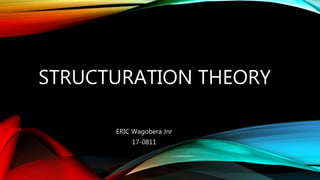
Structurational Theory
- 1. STRUCTURATION THEORY ERIC Wagobera Jnr 17-0811
- 2. INTRO • Structuration is from the noun structure and it refers to the state or process of organization in a structured form. • Being organized is vital for small groups which entails the proper arrangement of structures to guide their activities and interactions. • We live in a highly socialized world that stimulates the creation of social systems which in turn become the chief mediums of human interaction and activities.
- 3. STRUCTURATION THEORY • Humans communicate through structures to adopt procedures and activate resources needed to accomplish tasks, goals and resolutions. This gives birth to systems (Giddens, 1984). • Systems are the social hubs through which we interact, and achieve goals, i.e. small groups. • Systems rely on structures to function and sustain themselves.
- 4. STRUCTURATION THEORY • Through interactions, small groups produce structures (decision-making procedures, rules, leadership styles) to guide them (Miller, 2004). • In turn, the formed structures again produce systems, i.e. a vote by members to create a sports club. • Such is the recurring nature of small groups as systems; producing structures and structures producing systems (Haslett, 2015).
- 5. HISTORY • It’s attributed to Anthony Giddens a British sociologist who stated that social life is a relationship based on the duality of structure (agency & structure can only exist as a duality) and that structures are the rules, norms, languages, and beliefs that portray the social world. • Structures also have enabling and constraining abilities. Agency reflects the capacity of humans to make use of those structures within that social world (Miller, 2005).
- 6. KEY CONCEPTS Agency and reflexivity Active agents interact and recreate the social systems through their communication patterns. Various resources within our society and culture enable their actions, i.e. shared language, interaction procedures, and knowledge of the setting. As agents, humans act in both constrained and inventive ways – an indicator of a reflexive concept that makes them flexible in case of unexpected situations. Structures and systems The structure dualism is accounted for by the agent who is both empowered and restrained by the structures and that actions by the agent produces and reproduces systems – the rules and resources that constrain and empower interactions.
- 7. STRUCTURATION THEORY Structuration Processes Structures Systems Engagements Structures • Actions • Steps • Theorists study members’ attitudes & behaviors. • Medium for interactions • Rules/procedures • Resources for sustainability When structures are implemented, groups are formed. Members regularly interact per the guiding structures. They restrain and enable members’ comm’n attitudes & behaviors.
- 8. STRUCTURATION THEORY Who? ….. Agents (humans) What? …. Achieving goals (shared interests) Why? ….. Duality of structure (structure & agent) Where? …. Social spheres (private & public) How? ….. Structurational processes (systems & structures) 5 W’s and H
- 9. ASSUMPTIONS Humans undergo a socialization process and become dependent on the existing social structures. These structures affect and guide our groups’ activities. Social structures are a result of human activities and interactions. Such results can regulate (either restrain or enable) the agency’s behaviors. (University of Twente, 2003).
- 10. STRENGTHS It examines communication structures in action by focusing on the structuring process. Attention is on group interactions and how members adopt, create and maintain rules and resources. It helps us to understand the structures of even the smallest groups, i.e. clubs, committees, self-help groups. Therefore, the theory is applicable to a variety of small groups, not just those that perform decision- making and problem-solving functions (McGraw Hill, 2001). It takes into account the environmental forces that may encroach on group processes.
- 11. WEAKNESSES • It is considered as a highly complex and abstract theory. According to Banks and Riley (1993), the theory “lacks certain characteristics that communication researchers and other social scientists often find appealing”, i.e. not easily understood in a natural or parsimonious way due to its descriptive nature. • It doesn’t provide a means for predicting which circumstances or situations will result in the development of specific structures (Bryant & Jary, 1991).
- 12. WEAKNESSES • Since the structures are both system producers and also the outcome of the systems, it’s difficult to research structuration in small groups. So, researchers must closely examine each group member’s communication patterns as they put structures into action as well as the structures that arise from that interaction. • The definition of structuration suggests that group structures change over time, yet by just examining the group’s interactions, it’s often difficult to tell which structural changes occurred and when they occurred. • Its research primarily relies on case studies. Though it can be adapted to individual or specific cases, its flexibility makes it problematic to make generalizations based on this theory (McGraw Hill, 2001).
